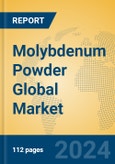Introduction
Molybdenum Powder is a high-performance metal powder derived from molybdenum, valued for its high melting point, corrosion resistance, and strength. It is primarily used in specialty steel, semiconductor applications, and other industrial uses such as coatings and catalysts. The molybdenum powder industry is characterized by its critical role in high-strength alloys and advanced electronics, driven by demand for durable materials in infrastructure, energy, and technology sectors. Key trends include the development of ultra-fine molybdenum powders for semiconductor applications, sustainable production methods to reduce environmental impact, and increased use in clean energy projects. The market is propelled by global infrastructure development, particularly in Asia Pacific, and growing semiconductor demand in electronics.Market Size and Growth Forecast
The global Molybdenum Powder market was valued at USD 0.7-1.4 billion in 2024, with an estimated CAGR of 5.0%-7.0% from 2025 to 2030, driven by demand in specialty steel and semiconductors.Regional Analysis
- North America is projected to grow at a CAGR of 4.8%-6.8%, with the U.S. leading due to its semiconductor and energy sectors, focusing on high-purity molybdenum powder.
- Europe is expected to achieve a CAGR of 4.5%-6.5%, with Germany driving demand through its emphasis on advanced manufacturing and clean energy.
- Asia Pacific is anticipated to record the highest growth at 5.5%-7.5%, led by China, where infrastructure and electronics manufacturing fuel demand, with trends toward cost-effective production.
- Rest of the World, particularly Chile, is expected to grow at 4.3%-6.3%, with trends toward industrial and energy applications.
Application Analysis
- Specialty steel applications are estimated to grow at a CAGR of 5.2%-7.2%, driven by molybdenum powder’s use in high-strength alloys for infrastructure, with trends toward corrosion-resistant grades.
- Semiconductor applications are projected to expand at 5.5%-7.5%, supported by demand in electronics, with innovations in ultra-fine powders for thin-film deposition.
- Other applications, including catalysts and coatings, are anticipated to grow at 4.8%-6.8%, with advancements in high-performance materials.
Key Market Players
A.L.M.T. Corp, headquartered in Tokyo, Japan, produces molybdenum powder for semiconductors, known for its advanced material technologies.JAPAN NEW METALS, based in Osaka, Japan, offers molybdenum powder for specialty steel, focusing on high-purity manufacturing.
Elmet Technologies, headquartered in Lewiston, Maine, USA, provides molybdenum powder for industrial applications, emphasizing integrated production.
Jinduicheng Molybdenum Co. Ltd., based in Xi’an, China, produces molybdenum powder for energy and electronics, known for its large-scale operations.
Porter’s Five Forces Analysis
- The threat of new entrants is low; high capital costs and technical expertise create barriers.
- The threat of substitutes is moderate; alternative alloying materials compete, but molybdenum’s unique properties maintain its edge.
- Buyer power is moderate; steel and semiconductor manufacturers negotiate pricing, but specialized applications limit leverage.
- Supplier power is moderate; molybdenum ore supply volatility impacts costs, but multiple sources reduce influence.
- Competitive rivalry is high; players differentiate through high-purity powders and sustainable production.
Market Opportunities and Challenges
Opportunities
- Growth in clean energy projects drives molybdenum powder demand in power generation.
- Expansion of semiconductor applications enhances market opportunities.
- Emerging markets in Asia Pacific offer growth potential due to infrastructure development.
Challenges
- Declining ore grades at copper mines impact molybdenum supply.
- Regulatory scrutiny, including export controls, increases compliance costs.
- Volatility in molybdenum prices challenges profitability.
Growth Trend Analysis
The Molybdenum Powder market is growing steadily, driven by demand in specialty steel and semiconductors. In 2024, global molybdenum reserves were approximately 15 million tons, with production at 260,000 tons, 90% from China, Peru, Chile, the U.S., and Mexico, with China supplying 40% of global production. Declining ore grades at porphyry copper mines continue to affect supply, with several mines expected to close by the mid-2030s. A Canadian company announced plans in 2024 to restart its idled Idaho molybdenum mine by 2027, with a ramp-up at its Pennsylvania facility. On October 6, 2025, Elmet Technologies signed a distribution agreement with TANIOBIS GmbH, enhancing its supply chain for high-quality molybdenum materials. On February 4, 2025, China implemented export controls on molybdenum products, potentially impacting global supply chains. These developments align with a projected CAGR of 5.0%-7.0% through 2030, reflecting molybdenum powder’s role in energy and electronics.This product will be delivered within 1-3 business days.
Table of Contents
Companies Mentioned
- A.L.M.T. Corp
- JAPAN NEW METALS
- Elmet Technologies
- Jinduicheng Molybdenum Co. Ltd








